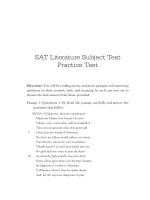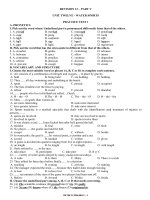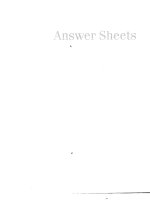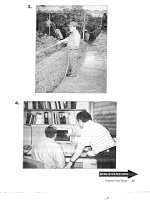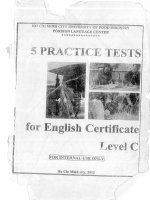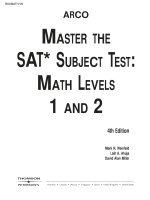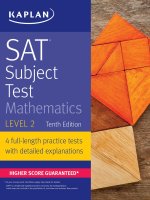SAT Subject Test chemistry 5 practice tests
Bạn đang xem bản rút gọn của tài liệu. Xem và tải ngay bản đầy đủ của tài liệu tại đây (1.33 MB, 320 trang )
THE TOP 40 THINGS YOU NEED
TO KNOW FOR TOP SCORES IN
CHEMISTRY
1. CHANGES
Understand and be able to identify the difference between physical and
chemical changes.
See Chapter 1.
2. REACTIONS
Understand and be able to identify the difference between exothermic and
endothermic reactions.
See Chapter 1.
3. MIXTURES
Know the differences between substances, mixtures, and the components of
mixtures.
See Chapter 1.
4. GAS LAWS AND CALCULATIONS
Be able to use the gas laws to calculate moles, pressure, volume, and mass of
a sample of gas at various temperatures and conditions.
See Chapter 2.
5. MATTER
Be able to name the changes in phases of matter and identify them on a heating/
cooling curve.
See Chapter 2.
6. SUBATOMIC PARTICLES
Understand the properties of the subatomic particles and how they allow isotopes to exist.
See Chapter 3.
7. ELECTRON CONFIGURATION
Be able to provide the electron configuration of an element given the number of electrons.
See Chapter 3.
8. MOLECULES
Know how to distinguish between the various hybridization states and the
shapes of molecules that can be formed.
See Chapter 3.
9. THE OCTET RULE
Understand the octet rule and how it allows atoms and ions to be stable.
See Chapter 3.
10. GROUPING AND THE PERIODIC TABLE
Know the properties and names of various groups/families within the periodic table.
See Chapter 4.
11. METALS, NONMETALS, AND THE PERIODIC TABLE
Know the properties and locations of the metals and nonmetals.
See Chapter 4.
12. TRENDS AND THE PERIODIC TABLE
Know the trends for electronegativity, ionization energy, and atomic radius
across the periodic table.
See Chapter 4.
13. BONDS
Be able to distinguish between the various intramolecular bonds: covalent
(polar vs. nonpolar), ionic, network covalent, hydrogen, coordinate covalent,
metallic, dispersion/Van der Waals, and molecule-ion attraction.
See Chapter 5.
14. SIGMA AND PI BONDS
Be able to tell the difference between sigma and pi bonds and be able to
locate them within a molecule.
See Chapter 5.
15. COMPOUNDS
Be able to name ionic and covalent compounds using both traditional methods
and the stock method.
See Chapter 5.
16. CHEMICAL EQUATIONS
Know how to balance and classify chemical equations.
See Chapter 6.
17. CALCULATIONS OF COMPOUNDS
Be able to calculate percent hydration and percent composition of a compound.
See Chapter 6.
18. SOLUBILITY RULES
Understand how to use solubility rules to predict the products of a reaction
and write net ionic equations.
See Chapter 6.
19. SOLUTIONS
Know how to calculate the concentration of a solution.
See Chapter 6.
20. THE MOLE
Understand how to use the mole to calculate the number of liters a gas will
occupy, the number of molecules present, the mass of a sample, and the number of moles of another substance in a reaction.
See Chapter 6.
21. POTENTIAL ENERGY DIAGRAMS
Be able to draw and label a potential energy diagram.
See Chapter 7.
22. HEAT
Know how to use a potential energy diagram and Hess’s Law to calculate heat
involved in reactions.
See Chapter 7.
23. RATE OF REACTION
Be able to determine how to change the rate of reaction.
See Chapter 8.
24. EQUILIBRIUM
Be able to determine how changing conditions changes the point of equilibrium of a reaction.
See Chapter 8.
25. PRODUCTS AND REACTANTS
Understand how to use Keq and Ksp values to find concentrations of products
and reactants.
See Chapter 8.
26. SPONTANEOUS REACTIONS
Know how to determine if a reaction will be spontaneous.
See Chapter 8.
27. ACIDS AND BASES
Understand the various operational and conceptual methods for defining
acids and bases.
See Chapter 9.
28. Ka
Understand what Ka can tell us about an acid or a base.
See Chapter 9.
29. MOLARITY AND pH
Know how to calculate the molarity and pH of an acid or a base solution.
See Chapter 9.
30. OXIDATION NUMBERS
Be able to determine the oxidation numbers for the elements in a compound.
See Chapter 10.
31. OXIDIZING AND REDUCING AGENTS
Know how to identify the substances that had a change in oxidation number and identify which serve as an oxidizing or a reducing agent in a halfreaction.
See Chapter 10.
32. REDOX REACTIONS
Be able to balance both simple and complex redox reactions.
See Chapter 10.
33. VOLTAIC AND ELECTROLYTIC CELLS
Know how to determine the reactions that occur within voltaic and electrolytic
cells.
See Chapter 10.
34. PREFIXES
Understand the prefixes used in organic chemistry so as to know the number
of carbon atoms present in a molecule.
See Chapter 11.
35. FUNCTIONAL GROUPS IN ORGANIC CHEMISTRY
Be able to distinguish between the various functional groups in organic
chemistry which contain oxygen, nitrogen, and double and triple bonds.
See Chapter 11.
36. RADIATION
Be able to identify the risks and benefits of using radiation.
See Chapter 12.
37. NUCLEAR EMANATIONS
Know the differences between various types of nuclear emanations.
See Chapter 12.
38. HALF-LIFE AND MASS CALCULATIONS
Be able to calculate the half-life of an isotope or the mass of a radioactive
sample after a certain period of time.
See Chapter 12.
39. LABORATORY TECHNIQUES
Understand safe and general laboratory techniques.
See Chapter 13.
40. LABORATORY CALCULATIONS
Know how to make all necessary calculations pertaining to experiments carried out in the laboratory.
See Chapter 13.
This page intentionally left blank
McGRAW-HILL’s
SAT
SUBJECT TEST
CHEMISTRY
This page intentionally left blank
McGRAW-HILL’s
SAT
SUBJECT TEST
CHEMISTRY
Second Edition
Thomas A. Evangelist
Assistant Principal, Supervision of Science
New York City Department of Education
New York / Chicago / San Francisco / Lisbon / London / Madrid / Mexico City
Milan / New Delhi / San Juan / Seoul / Singapore / Sydney / Toronto
Copyright © 2009 by The McGraw-Hill Companies, Inc. All rights reserved. Except as permitted under the United States Copyright Act of 1976, no part
of this publication may be reproduced or distributed in any form or by any means, or stored in a database or retrieval system, without the prior written
permission of the publisher.
ISBN: 978-0-07-160885-5
MHID: 0-07-160885-0
The material in this eBook also appears in the print version of this title: ISBN: 978-0-07-160884-8, MHID: 0-07-160884-2.
All trademarks are trademarks of their respective owners. Rather than put a trademark symbol after every occurrence of a trademarked name, we use
names in an editorial fashion only, and to the benefit of the trademark owner, with no intention of infringement of the trademark. Where such
designations appear in this book, they have been printed with initial caps.
McGraw-Hill eBooks are available at special quantity discounts to use as premiums and sales promotions, or for use in corporate training programs. To
contact a representative please e-mail us at
This publication is designed to provide accurate and authoritative information in regard to the subject matter covered. It is sold with the understanding
that neither the author nor the publisher is engaged in rendering legal, accounting, futures/securities trading, or other professional service. If legal advice
or other expert assistance is required, the services of a competent professional person should be sought.
—From a Declaration of Principles jointly adopted by a Committee of the American Bar Association and a Committee of Publishers
SAT is a registered trademark of the College Entrance Examination Board, which was not involved in the production of, and does not endorse, this
product.
TERMS OF USE
This is a copyrighted work and The McGraw-Hill Companies, Inc. (“McGraw-Hill”) and its licensors reserve all rights in and to the work. Use of this
work is subject to these terms. Except as permitted under the Copyright Act of 1976 and the right to store and retrieve one copy of the work, you may not
decompile, disassemble, reverse engineer, reproduce, modify, create derivative works based upon, transmit, distribute, disseminate, sell, publish or sublicense the work or any part of it without McGraw-Hill’s prior consent. You may use the work for your own noncommercial and personal use; any other
use of the work is strictly prohibited. Your right to use the work may be terminated if you fail to comply with these terms.
THE WORK IS PROVIDED “AS IS.” McGRAW-HILL AND ITS LICENSORS MAKE NO GUARANTEES OR WARRANTIES AS TO THE ACCURACY, ADEQUACY OR COMPLETENESS OF OR RESULTS TO BE OBTAINED FROM USING THE WORK, INCLUDING ANY
INFORMATION THAT CAN BE ACCESSED THROUGH THE WORK VIA HYPERLINK OR OTHERWISE, AND EXPRESSLY DISCLAIM ANY
WARRANTY, EXPRESS OR IMPLIED, INCLUDING BUT NOT LIMITED TO IMPLIED WARRANTIES OF MERCHANTABILITY OR FITNESS
FOR A PARTICULAR PURPOSE. McGraw-Hill and its licensors do not warrant or guarantee that the functions contained in the work will meet your
requirements or that its operation will be uninterrupted or error free. Neither McGraw-Hill nor its licensors shall be liable to you or anyone else for any
inaccuracy, error or omission, regardless of cause, in the work or for any damages resulting therefrom. McGraw-Hill has no responsibility for the content
of any information accessed through the work. Under no circumstances shall McGraw-Hill and/or its licensors be liable for any indirect, incidental,
special, punitive, consequential or similar damages that result from the use of or inability to use the work, even if any of them has been advised of the
possibility of such damages. This limitation of liability shall apply to any claim or cause whatsoever whether such claim or cause arises in contract, tort
or otherwise.
Dedicated to:
My loving and supportive family,
My students who are worth all the effort,
My friends who have been there over the years,
My colleagues who have been behind me 100 percent,
My teammates who put it all on the line game after game,
Everyone who has taught me something over the past 30-plus years.
Let’s never stop learning. . . .
This page intentionally left blank
CONTENTS
PART I. INTRODUCTION TO THE SAT CHEMISTRY TEST
1
All About the SAT Chemistry Test / 3
How to Use This Book / 9
Strategies for Top Scores / 10
PART II. DIAGNOSTIC TEST
15
Diagnostic Test / 17
Answers and Explanations to Diagnostic Test / 29
PART III. CHEMISTRY TOPIC REVIEW
Chapter
Chapter
Chapter
Chapter
Chapter
Chapter
Chapter
Chapter
Chapter
Chapter
Chapter
Chapter
Chapter
1
2
3
4
5
6
7
8
9
10
11
12
13
39
Matter and Energy / 41
Phases of Matter / 47
Atomic Structure / 60
The Periodic Table and Periodic Trends / 76
Bonding / 84
Stoichiometry and Solution Chemistry / 101
Energy and Chemical Reactions / 118
Reaction Rates and Chemical Equilibrium / 127
Acids and Bases / 139
Redox and Electrochemistry / 151
Organic Chemistry / 167
Nuclear Chemistry / 176
Laboratory Skills / 185
PART IV. FOUR FULL-LENGTH PRACTICE TESTS
195
Practice Test 1 / 197
Answers and Explanations / 210
Practice Test 2 / 219
Answers and Explanations / 230
Practice Test 3 / 239
Answers and Explanations / 251
Practice Test 4 / 261
Answers and Explanations / 274
APPENDIXES
283
Appendix 1
Appendix 2
Mathematical Skills Review / 285
Equations and Symbols / 289
Appendix 3
Appendix 4
Appendix 5
Periodic Table of the Elements / 291
Reference Tables / 293
Glossary / 295
xiii
This page intentionally left blank
McGRAW-HILL’s
SAT
SUBJECT TEST
CHEMISTRY
This page intentionally left blank
PART I
INTRODUCTION
TO THE SAT
CHEMISTRY
TEST
This page intentionally left blank
All About the SAT Chemistry Test
THE SAT SUBJECT TESTS
What Are the SAT Subject Tests?
The SAT Subject Tests (formerly called the SAT II tests and the Achievement
Tests) are a series of college entrance tests that cover specific academic subject
areas. Like the better-known SAT test, which measures general verbal and
math skills, the SAT Subject Tests are given by the College Entrance Examination Board. Colleges and universities often require applicants to take one
or more SAT Subject Tests along with the SAT.
SAT Subject Tests are generally not as difficult as Advanced Placement
tests, but they may cover more than is taught in basic high school courses.
Students usually take an SAT Subject Test after completing an Advanced
Placement course or an Honors course in the subject area.
How Do I Know if I Need to Take SAT Subject Tests?
Review the admissions requirements of the colleges to which you plan to
apply. Each college will have its own requirements. Many colleges require
that you take a minimum number of SAT Subject Tests—usually one or two.
Some require that you take tests in specific subjects. Some may not require
SAT Subject Tests at all.
When Are SAT Subject Tests Given, and How Do I Register for Them?
SAT Subject Tests are usually given on six weekend dates spread throughout the academic year. These dates are usually the same ones on which the
SAT is given. To find out the test dates, visit the College Board Web site at
www.collegeboard.com. You can also register for a test at the Web site. Click
on the tabs marked “students” and follow the directions you are given. You
will need to use a credit card if you register online. As an alternative, you can
register for SAT Subject Tests by mail using the registration form in the SAT
Registration Bulletin, which should be available from your high school guidance counselor.
How Many SAT Subject Tests Should I Take?
You can take as many SAT Subject Tests as you wish. According to the College Board, more than one-half of all SAT Subject Test takers take three tests,
and about one-quarter take four or more tests. Keep in mind, though, that you
can take only three tests on a single day. If you want to take more than three
tests, you’ll need to take the others on a different testing date. When deciding
how many SAT Subject Tests to take, base your decision on the requirements
of the colleges to which you plan to apply. It is probably not a good idea to
take many more SAT Subject Tests than you need. You will probably do
better by focusing only on the ones that your preferred colleges require.
3
4
PART I / INTRODUCTION TO THE SAT CHEMISTRY TEST
Which SAT Subject Tests Should I Take?
If a college to which you are applying requires one or more specific SAT
Subject Tests, then of course you must take those particular tests. If the college simply requires that you take a minimum number of SAT Subject Tests,
then choose the test or tests for which you think you are best prepared and
likely to get the best score. If you have taken an Advanced Placement course
or an Honors course in a particular subject and done well in that course, then
you should probably consider taking an SAT Subject Test in that subject.
When Should I Take SAT Subject Tests?
Timing is important. It is a good idea to take an SAT Subject Test as soon as
possible after completing a course in the test subject, while the course material is still fresh in your mind. If you plan to take an SAT Subject Test in a
subject that you have not studied recently, make sure to leave yourself
enough time to review the course material before taking the test.
What Do I Need on the Day of the Test?
To take an SAT Subject Test, you will need an admission ticket to enter the
exam room and acceptable forms of photo identification. You will also
need two number 2 pencils. Be sure that the erasers work well at erasing
without leaving smudge marks. The tests are scored by machine, and scoring can be inaccurate if there are smudges or other stray marks on the answer sheet.
Any devices that can make noise, such as cell phones or wristwatch
alarms, should be turned off during the test. Study aids such as dictionaries
and review books, as well as food and beverages, are barred from the test
room.
THE SAT CHEMISTRY TEST
What Is the Format of the SAT Chemistry Test?
The SAT Chemistry test is a one-hour exam consisting of 85 multiple-choice
questions. According to the College Board, the test measures the following
knowledge and skills:
• Familiarity with major chemistry concepts and ability to use those concepts to solve problems
• Ability to understand and interpret data from observation and experiments and to draw conclusions based on experiment results
• Knowledge of laboratory procedures and of metric units of measure
• Ability to use simple algebra to solve word problems
• Ability to solve problems involving ratio and direct and inverse proportions, exponents, and scientific notation
The test covers a variety of chemistry topics. The following chart shows the
general test subject areas, as well as the approximate portion of the test devoted to each subject.
ALL ABOUT THE SAT CHEMISTRY TEST
5
SAT Chemistry Subject Areas
Subject Area
Approximate Percentage of Exam
1. Structure of Matter
25%
2. States of Matter
15%
3. Reaction Types
14%
4. Stoichiometry
12%
5. Equilibrium and Reaction Rates
7%
6. Thermodynamics
6%
7. Descriptive Chemistry
8. Laboratory
13%
8%
When you take the SAT Chemistry test, you will be given a test booklet
that includes a periodic table of the elements. The table will show only the
element symbols, atomic numbers, and atomic masses. It will not show electron configurations or oxidation numbers. You may not use your own reference tables or a calculator.
What School Background Do I Need for the SAT Chemistry Test?
The College Board recommends that you have at least the following experience before taking the SAT Chemistry test:
• One-year chemistry course at the college preparatory level
• One-year algebra course
• Experience in the chemistry laboratory
How Is the SAT Chemistry Test Scored?
On the SAT Chemistry test, your “raw score” is calculated as follows: You
receive one point for each question you answer correctly, but you lose onequarter point for each question you answer incorrectly. You do not gain or
lose any points for questions that you do not answer at all. Your raw score is
then converted into a scaled score by a statistical method that takes into
account how well you did compared to others who took the same test. Scaled
scores range from 200 to 800 points. Your scaled score will be reported to
you, to your high school, and to the colleges and universities that you designate to receive it.
Scoring scales differ slightly from one version of the test to the next. The
scoring scales provided after each practice test in this book are only samples
that will show you your approximate scaled score.
6
PART I / INTRODUCTION TO THE SAT CHEMISTRY TEST
When Will I Receive My Score?
Scores are mailed to students approximately three to four weeks after the
test. If you want to find out your score a week or so earlier, you can do so for
free by accessing the College Board Web site or for an additional fee by calling (866)756-7346.
How Do I Submit My Score to Colleges and Universities?
When you register to take the SAT or SAT Subject Tests, your fee includes
free reporting of your scores to up to four colleges and universities. To have
your scores reported to additional schools, visit the College Board Web site
or call (866)756-7346. You will need to pay an additional fee.
SAT CHEMISTRY QUESTION TYPES
The SAT Chemistry test consists entirely of multiple-choice questions. Most
are the regular five-answer-choice format that you will be familiar with
from taking other standardized tests. Some, however, have special formats
that do not appear on other tests and that you need to be aware of. The
College Board calls these formats “classification sets” and “relationship
analysis questions.” Review the following examples before you tackle the
Diagnostic Test.
Regular Multiple-Choice Questions
On the SAT Chemistry test, most of the questions are in the regular fiveanswer-choice format that is used on standardized tests such as the SAT.
Here is an example:
1. Which oxidation half reaction below demonstrates conservation of mass
and charge?
(A)
Mg2+ + 2e– → Mg
(B)
Cl1− + 1e– → Cl2
(C)
2Ag1+ → 2Ag +1e–
(D)
Mg → Mg2+ + 2e–
(E)
F2 + 2e– → 2F1−
The correct answer is choice D. Note that with this question, as with many
other questions on the test, you can find the correct answer by using the
process of elimination. The half reactions shown in choices A, B, and E are
all reduction half reactions, so those choices can be eliminated. Both remaining choices, C and D, show oxidation and a loss of electrons. But
choice C does not demonstrate conservation of charge and mass; if it did,
there would have to be two electrons on the left side of the reaction. So the
correct answer must be choice D.
You will see a variation of this basic format in which you are offered three
choices indicated by the Roman numerals I, II, and III. Your task is to decide which combination of the three choices answers the question. Here is
an example:
ALL ABOUT THE SAT CHEMISTRY TEST
7
2. Which of the following indicates an acidic solution?
I.
Litmus paper turns blue.
II.
Phenolphthalein turns pink.
III. Hydronium ion concentration is greater than hydroxide ion concentration.
(A) I only
(B) II only
(C) III only
(D) I and II only
(E) I, II, and III
The correct answer is choice C. First, review the choices. Choices I and II indicate a basic solution. If they were acidic, then the solutions would be red
for litmus and clear for phenolphthalein. Only choice III holds true for an
acidic solution. In an acidic solution the concentration of hydronium ions exceeds that of hydroxide ion concentration.
Classification Sets
In a classification set, you are given five answer choices lettered A through E.
The choices may be chemistry principles, substances, numbers, equations,
diagrams, or the like. The choices are followed by three or four numbered
questions. Your task is to match each question with the answer choice to
which it refers. Here are sample directions for a classification set, followed
by a sample of this question format.
Directions: Each of the following sets of lettered choices refers to the numbered formulas or
statements immediately below it. For each numbered item, choose the one lettered choice that
fits it best. Then fill in the corresponding oval on the answer sheet. Each choice in a set may be
used once, more than once, or not at all.
Questions 3–5:
(A)
(B)
(C)
(D)
(E)
Coordinate covalent bonding
Ionic bonding
Nonpolar covalent bonding
Metallic bonding
Hydrogen bonding
3. HF
4. N2
5. KI
3. The correct answer is choice E. The bond between the atoms of hydrogen and fluorine is a polar covalent bond, a choice that is not present in
the choices above. Now look at the bonding between the molecules of HF.
HF can exhibit dipole forces between its molecules, yet another choice that
is not present. HF can, however, exhibit hydrogen bonding, a choice that
is present.
8
PART I / INTRODUCTION TO THE SAT CHEMISTRY TEST
4. The correct answer is choice C. Nitrogen gas has no difference in electronegativity between the nitrogen atoms. The two nitrogen atoms will form a
nonpolar covalent bond. The type of bonding present between the molecules
of nitrogen gas will be dispersion forces, the forces present between nonpolar
molecules.
5. The correct answer is choice B. Potassium iodide is formed from a metal,
potassium, and a nonmetal, iodine. The type of bonding that forms between
metals and nonmetals is ionic bonding.
Relationship Analysis Questions
Relationship analysis questions are probably not like any question type that
you have seen before. Each question consists of two statements labeled I and
II with the word BECAUSE between the two statements. For each question,
you have three tasks. You must:
• Determine if statement I is true or false.
• Determine if statement II is true or false.
• Determine if statement II is the correct explanation for statement I.
On the answer sheet, you will mark true (T) or false (F) for each statement, and
you will mark “correct explanation” (CE) ONLY if statement II is a correct explanation of statement I. Here are sample directions for this kind of question,
followed by two examples and a sample of a correctly marked answer sheet.
Directions: Each question below consists of two statements. For each question, determine
whether statement I in the leftmost column is true or false and whether statement II in the rightmost column is true or false. Fill in the corresponding T or F ovals on the answer sheet provided. Fill in the oval labeled “CE” only if statement II correctly explains statement I.
101 HCl is an Arrhenius acid
BECAUSE
HCl is a proton donor.
102 Water is a polar molecule
BECAUSE
the dipole forces in a molecule of
water will counterbalance each other
and cancel out.
101.
T, T, CE HCl will donate a proton (hydronium ion) when it reacts.
This classifies it as an Arrhenius acid.
102.
T, F
Because of the bent shape of a water molecule, the dipole
forces in the molecule will not counterbalance or cancel
out. This is what causes a water molecule to be a polar
molecule.
Here is how you would mark these answers on the answer sheet:
I
101
102
II
F
F
F
CE*
T
